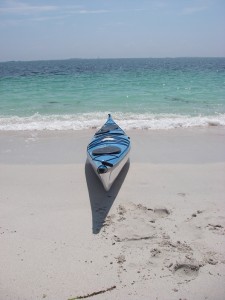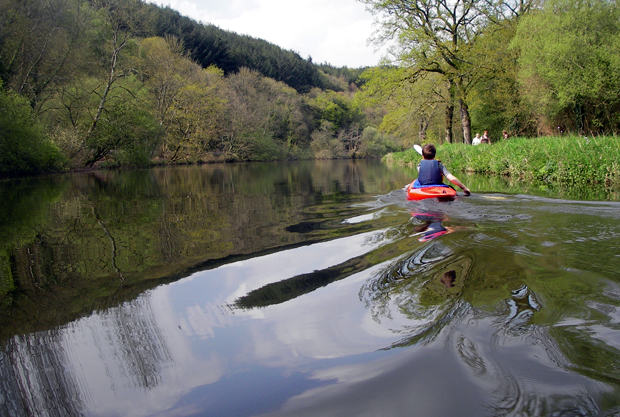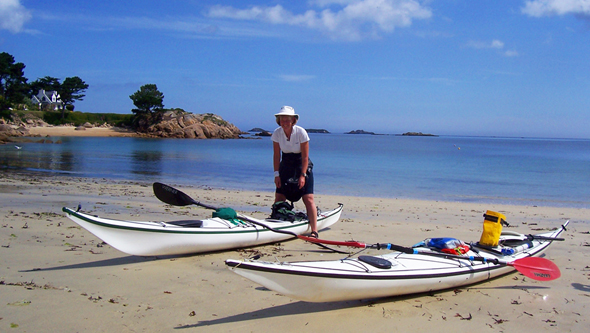
24 July 2012 by Jessica Boston and Bill Beetham
Top 10 Tips for Kayaking in France
The Guardian newspaper named Brittany as one of their top ten sea kayaking holiday destinations and it’s not hard to see why; a wide variety of routes and scenic coastlines make this an ideal place for kayakers of all abilities. Here are our top tips for successful kayaking in France…
1. Explore Brittany’s coastline
Brittany has a wealth of coastline kayaking opportunities so take time to explore the options and choose routes that suit your abilities. Generally speaking the west and north coasts offer a greater tidal range and stronger tidal flow whilst the southern coast provides calmer conditions (with some notable exceptions).
Some areas to consider when planning your trips include:
Golfe du Morbihan
An expanse of water on the east side of the southern Brittany coast that is dotted with islands, some inhabited, the majority offering landing points and one even featuring megalithic monuments.
It’s not uncommon for the tidal flow at the entrance to the Golfe to reach in excess of 8 knots as the full force of the Atlantic tide floods in making for interesting currents and conditions, ideal for an agile kayaker but sometimes tough going even for the powerful inter-island ferries.
Etel estuary
The coast here can be very challenging as it is fully exposed to the waves and swell coming in from the Atlantic. A narrow passage opposite Saint Cado is a popular play spot for sea and white water paddlers, while the interior is much more sheltered.
Quiberon peninsula
The Quiberon peninsula has two sides, the first, aptly named ‘Cote Sauvage’, which bears the full force of the prevailing wind and waves, and the calm, sheltered side bordering the Quiberon Bay.
Ile de Groix
A magical island a few kilometers south off the coast at Lorient ideal for a day trip return crossing or circumnavigation if conditions permit. Rocky ledges on the south-eastern tip throw up heavy surf so the less intrepid may wish to avoid that area.
Bréhat Archipelago
A collection of pink granite islands and islets submerged at high water and revealed as the tide recedes – a jewel in the crown of the north Brittany coast.
Glénan Archipelago
White sand beaches and turquoise waters make this a beautiful day trip destination for competent, experienced paddlers.
2. Find safety in numbers
The saying in the sport is “Less than 3 there should never be”. Not only is sea kayaking in a group more fun, it’s also much safer. Aim to paddle with others who have a similar ability and outlook – it’s no good pairing up with a speed demon if you’re looking to enjoy the scenery at a more relaxed pace.
Sticking together is even more important when you travel some of the more remote routes, and it’s a wonderful experience to share with friends or family.
If you’re keen to sea kayak in France and don’t have a couple of fellow paddlers to hand the best thing to do is sign up for an organised tour or course where you can go out with professional kayakers who know the local area – solo trips in unfamiliar waters are not recommended even for confident paddlers with plenty of experience.
3. Choose your tidal windows
With any sea kayaking expedition, planning is vital and particular attention should be paid to tidal windows that allow you to paddle with rather than against the current.
Consult a tide table before setting out on your trip and pay attention to the ‘coefficient’ used in the French system. In simple terms the higher the coefficient the greater the tidal range will be and the stronger the accompanying currents you’ll be likely to encounter.
Miscalculating timings or failing to plan properly can result at best in an extremely long carry up the beach after a long day’s paddle, and at worst can put you in an extremely dangerous situation facing currents that make progress impossible, even for the strongest paddler.
4. Be prepared to change your plans
After all your careful planning it may be tempting to ignore the grey clouds on the horizon but do so at your peril. Checking up to the minute weather conditions using atmospheric pressure charts and nautical forecasts is vital, and in Brittany there is such a variety of kayaking opportunities that even if your planned trip is not possible you’re sure to find an alternative river or piece of coastline within reach that is safe to explore.
5. Mess about on the river
For those who prefer to travel by river, or sea kayakers looking for a change of pace, Brittany has a variety of river and canal routes to offer ranging from the sedate and scenic to the thrilling and challenging.
Lochrist White Water Centre
Made by diverting the Blavet River around strategically positioned rocks and standing stones, the unique Lochrist White Water Centre allows kayakers to navigate down the watercourse before being raised back up to the start on a conveyer belt system so the fun can start again.
Each June the ’24 Heures de Lochrist’ challenge sees teams compete (often in fancy dress) to complete as many circuits as possible with the fewest possible capsizes – a spectacle that’s definitely well worth a visit if you’re in the area!
Pontivy to Hennebont
Follow the Blavet river, a 60km stretch of tranquil, unspoilt waterway from its junction with the Nantes-Brest Canal to Hennebont where it becomes tidal. The route is punctuated with almost 30 locks that can be portaged or ‘run’ using purpose built canoe slides.
South coast rivers
The Odet, Laita, Belon and Aven rivers all offer plenty of independent paddling opportunities.
North western coast inlets
Aber Ildut, L’Aber Wrac’h and Aber Benoît provide sheltered paddling but are subject to tidal forces so don’t forget to check the time and height of the tide to ensure the beach or jetty you launch from will not be left high and dry by the time you return!
6. Get the right accommodation and equipment hire
For the keen kayaker travelling by car it may be easy enough to come prepared with all your own equipment, but for the those who prefer to travel lighter you’ll find there are plenty of rental companies in the region offering kayak and canoe hire.
You’ll also find a fair few gîtes and holiday homes that offer use of kayaks and life jackets in the price of the rental. And if you’re lucky you’ll even get some invaluable first hand advice on the local waterways from a fellow paddler.
Choose from coastal locations and riverside destinations and be prepared to travel around to experience the full range of kayak opportunities in the region. Spend a week or a fortnight exploring the area or just dip a toe in the water with a two or three day mini break.
7. Make the most of the sightseeing opportunities
Kayaking offers a unique perspective from which to view and explore the beautiful natural coastline and rivers of Brittany. You can reach remote islands and beaches other modes of transport cannot get to and experience being at one with the forces of nature.
You can also use kayaking as a means of visiting some more mainstream attractions Brittany has to offer, for example by taking a trip from the mouth of the Aven river at Port Manech to the picturesque town of Pont Aven, famed for its association with Impressionist painter Gauguin and home to a treasure trove of art shops and galleries.
8. Enjoy perfect picnics
Many kayak trips necessitate the packing of provisions for a meal or two al fresco during the day. If you are exploring the more rural, unspoilt locations you’ll need to ensure you take everything you need with you.
French cuisine offers the chance to feast like a king with cheeses, cold meats and fresh bread an easy and delicious choice. The more adventurous chef might even like to try cooking up some mussels freshly picked from the rocks for a mouthwatering treat.
It is well known amongst kayakers that the bottom of the boat provides a perfect place to chill a bottle of white wine, but moderation is advised in order to ensure a safe homeward journey!
Also make sure to pack enough water to keep hydrated throughout the day, particularly important in hotter weather.
9. Improve your skills and local knowledge
If you are a beginner or looking to hone your sea kayaking skills, Brittany has plenty of operators dotted around the coast offering day trips or short courses with qualified kayak instructors.
Check your chosen provider is licensed by the FFCK (the French equivalent of the British Canoe Union) to ensure instructors are properly qualified and boats and equipment are kept in good order.
Expect to pay between €45-€60 for a day out with an instructor.
10. Know the regulations and safety requirements
All paddlers are required to carry appropriate safety equipment according to the distance from shore you are travelling.
This will include charts of the area with tidal flow information, a buoyancy aid, a magnetic compass, spare paddles, paddle floats, flares, a bailing mechanism, deck lines, tow lines and towing point, signaling mirrors and an audible means of attracting attention.
French law states that sea kayakers must remain within six nautical miles (approximately 12kms) from a point of shelter so an open water trip of twice this distance is the maximum permitted. For a full summary of current legal requirements for kayaking in France consult the Fédération Francaise de Canoe-Kayak (FFCK) website.




Great tips indeed! I am big fun of Bretagne and apart of Ile de Groix you could also try kayaking on the Ile de Houat et Hoedic but stay careful beacause the currents are very strong there!